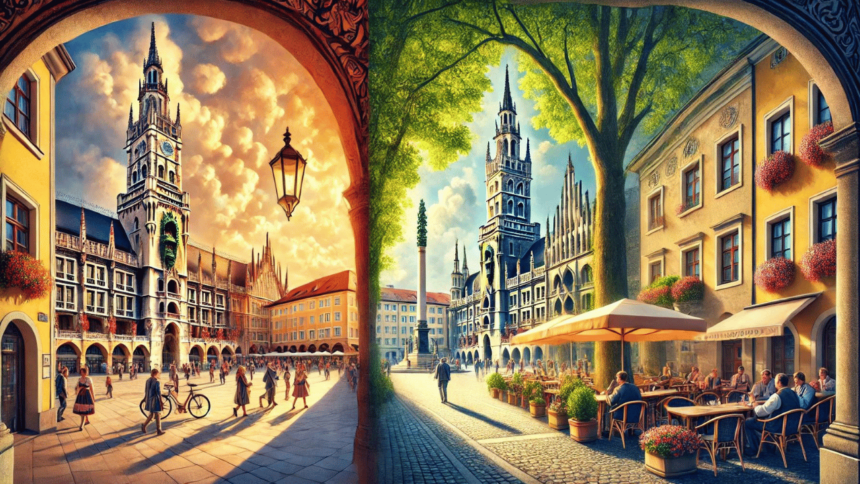The term маријин трг uniquely identifies two remarkable squares steeped in history and culture in two regions: Munich, Germany, and a quaint town in Serbia. While sharing a name that translates to “Mary’s Square” in English, both places offer distinct experiences reflective of their cultural heritage and historical significance.
маријин трг in Munich: A Gateway to Bavarian Tradition
Located at the core of Munich, Marienplatz (маријин трг) is not just a public square; it’s a historical tapestry that captures the essence of Bavarian tradition and festivity. Established in 1158, this square has been the civic heart of Munich, witnessing numerous pivotal events from medieval jousts to modern-day celebrations like Oktoberfest.
Historical Significance
Marienplatz is adorned by the Mariensäule, a golden statue of the Virgin Mary atop a column built in 1638 to honor the end of Swedish occupation during the Thirty Years’ War. This iconic landmark is surrounded by structures that narrate Munich’s rich history, including the New and Old Town Halls.
Cultural Hub
Throughout the year, маријин трг in Munich transforms into a bustling hub of activity. The square is a focal point of Bavarian culture and social life, from the Christkindlmarkt (Christmas market) that lights up in the winter to the vibrant spectacles of musicians and performers in the summer.
Link to Beer Culture
Proximity to famed establishments like Hofbräuhaus and Viktualienmarkt ties Marienplatz closely to Munich’s legendary beer culture. These locations provide a thorough dive into the world of Bavarian brews, making the square a starting point for anyone looking to explore the city’s historical love affair with beer.
маријин трг in Serbia: A Serene Glimpse into Local Life
Contrasting the grandeur of Munich’s Marienplatz, маријин трг in Serbia presents a tranquil yet equally enriching experience. Located in a small, unnamed Serbian town, this square offers a peaceful retreat into the everyday life of the locals.
Local Charm and Authenticity
маријин трг in Serbia is celebrated for its understated beauty and authentic experience. Far from the tourist trails, it’s a place where one can observe the slow-paced life of a Serbian town, enjoy traditional cuisine, and interact with friendly locals.
Economic and Social Importance
The square is surrounded by family-owned cafes, shops, and eateries, making it a vital part of the local economy. It supports small businesses and serves as a community gathering place where traditions are kept alive and shared with visitors.
Best Time to Visit
The ideal time to visit маријин трг in Serbia is during the spring and summer months when the weather is pleasant, and the square is lively with local events and activities.
Comparative Analysis
While both squares share the name маријин трг, their roles and atmospheres differ significantly. Munich’s Marienplatz is a historic epicenter that draws tourists to its monumental architecture and grand festivals globally. In contrast, Serbia’s маријин трг offers an intimate, authentic experience that highlights the serene charm of Serbian life.
Conclusion
маријин трг, whether in Munich or Serbia, exemplifies the rich cultural fabric of their respective regions. Each offers unique experiences catering to different types of travelers: those seeking grand historical narratives or a quiet, authentic encounter. Both squares preserve their heritage and foster community spirit and cultural pride as centers of social and cultural activities.
FAQs about маријин трг
What is маријин трг?
маријин трг refers to two significant squares in Europe. One is Marienplatz in Munich, Germany, known for its historical and cultural importance, and the other is a lesser-known but charming square in a small town in Serbia, offering a glimpse into local Serbian life.
Why is маријин трг important in Munich?
маријин трг, or Marienplatz, is Munich’s central square. Since its foundation in 1158, it has been pivotal in the city’s history. It hosts critical social and cultural events, including the Oktoberfest, and is surrounded by historic landmarks like the New and Old Town Halls.
What can visitors do at маријин трг in Serbia?
Visitors to маријин трг in Serbia can enjoy a serene atmosphere, explore local cafes and shops, and engage with the community. The square is ideal for experiencing traditional Serbian culture away from the bustling tourist paths.
What is the best time to visit маријин трг in Munich and Serbia?
For Munich, the best time is during significant cultural events like Oktoberfest (late September to early October) or the Christmas markets in December. In Serbia, spring and summer are ideal for visiting when the weather is pleasant, and the square is lively with local activities.
Are there guided tours available at маријин трг in both locations?
In Munich, guided tours explore Marienplatz’s historical and architectural significance. While formal guided tours might not be available in Serbia, residents are often willing to share insights about their town and its history.






